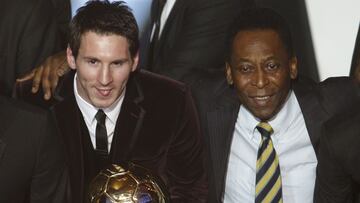Pelé or Messi: who was better?
Since Pelé retired, each new star has been compared to the ‘O Rei’. But perhaps no one has left more arguments than ‘the Pelé’ of this generation, Lionel Messi.

Pelé or Messi? Messi or Pelé? After the death of the ‘Rei do Futebol’ who has left a mark in history on some of the most important achievements that have ever been seen and will probably be seen again in this sport, the debate arises. Is Messi at the level of Pelé?
Since Pelé's retirement, every superstar of his generation has been compared to ‘’the king’, including Maradona, Sócrates, Zico, Platini, Ronaldo Nazário, Zidane, and Ronaldinho. Each era has had ‘its’ candidate for Pelé. But perhaps no one has created a more interesting comparative debate than ‘the Pelé’ of this generation, Lionel Messi.
The Argentinian has been an extraordinary player for more than a decade now. In an increasingly internationalized and global football world, Messi continues to shine alone as arguably the best out there. His only rival is Cristiano Ronaldo, who is only capable of competing with Messi year after year for the Ballon d’Or thanks to his effectiveness in front of goal, and titles with Real Madrid and the Portuguese team.
The Ballon d’Or record
When Messi won his sixth Ballon d’Or in December 2019, the Argentinian moved closer to equaling Pelé's record. Back when the Brazilian played, France Football only rewarded European footballers- a rule that was maintained until 1995, when the magazine began to also accept those who play in Europe, regardless of their nationalities. In 2007, the most traditional award for the best player in the world became global.
The change in the Ballon d’Or rules allowed France Football to make a historical correction. In 2014, the magazine revised its entire list of winners using the same criteria currently valid and awarded Pelé seven trophies as the world’s best player: 1958, 1959, 1960, 1961, 1963, 1965 and 1970.
With that, Pelé became not only the record holder for the number of trophies, but also the youngest winner, at the age of 17, surpassing Ronaldo Nazário, who had won in 1997 at the age of 21 years and three months.
During the ceremony held in 2014 by France Football, Pelé was very emotional. He thanked his teammates and workers from the clubs and national team for the conquest. “I promised my family that I was not going to cry, but this is too much. I just have to thank God for giving me the health to play for so many years. And I didn’t play alone. All I won was next to my friends. People remember the players, but we can’t forget the people who prepare the boots, the physios, the masseurs... I share these trophies with all of you,” Pelé said through tears.
Today’s football vs football back then
Pelé himself, with his humble character, said several times that “it is much more difficult” to play football today, and that during his time “they had more freedom.” But the King forgot that there were other difficulties in his time.
“The ball and the boots, for example, were made of genuine leather and, with each kick, you could hear the last mooing of the animal that that leather lowered,” explains Ruy Castro in his book ‘Os Garotos do Brasil’. “They were coarse and heavy, and with the wet grass, they weighed twice as much as their original weight,” says the writer.
The grass and fields of yesteryear are a chapter apart. They were potato fields, and goat paths, with so many potholes and pits that the porters had to wear knee pads. The shirts were not ‘dry fit.’ They were made of sailor cloth, which at the end of the 90 minutes weighed almost as much as carrying a partner on your shoulders. Between the boots, balls, shirts, and fields, imagine the effort required to finish off a corner or cross with a header in those days.
No cards or tactical analysis
But apart from winning the three-time World Cup with the Brazilian team, something that no other footballer has achieved, perhaps the best argument in favor of Pelé is that he has reached practically all his achievements in football when there were no cards. Pelé started playing in 1956 and FIFA did not create the bookings until May 1970. Former players say that the main tactic of the rivals against Santos or Pelé was to go for the ‘10′. They took turns giving it. One can only imagine what Pelé would have done 15 years in football with yellow and red cards.
In those days there was no scouting, videos, or tactical analysis. A team was up against opponents who had little or no idea how they played. It was like Russian roulette.
The star among all superstars
If today the dispute to be the best in the world is a fight between only two legends, Messi and Cristiano Ronaldo, then imagine how different it was back then. We’re talking about Di Stefano, Puskas, Bobby Charlton, Garrincha, Evaristo, Kopa, Fontaine, Eusébio, Gerd Müller, Tostão, Jairzinho, Rivelino, Cruyff... And still, Pelé was the best among different generations of stars who marked an era. That’s without counting the defenders and goalkeepers he faced: Yashin, Banks, Maier, Zoff, Castilho, Beckenbauer, Djalma Santos, Bob Moore, Nilton Santos, Breitner, Krol.
The controversy over the goals and the ‘unofficial’ matches
Another debate is the goals. According to a survey carried out by Diario As in 2019, based on data from Santos, the CBF, the Brazilian television network Rede Globo and the book ' ‘Pelé'’ by Orlando Duarte, the Brazilian has scored 1,283 goals in 786 matches. 743 of these goals were in 449 of what we would call official matches today. And another 540 in 337 friendlies.






